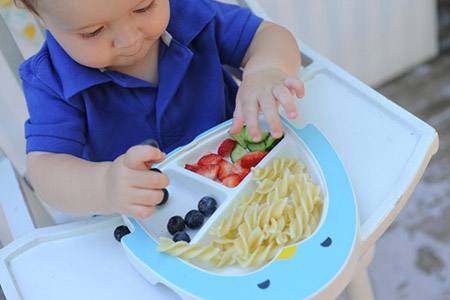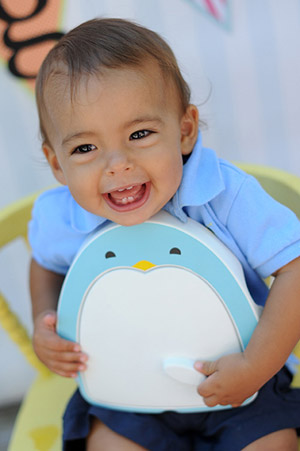
UC San Diego Students Help Design Toddler-Tantrum-Proof Plate
Published Date
By:
- Ioana Patringenaru
Share This:
Article Content

The Adi plate includes three compartments for food.
It’s a scene that many parents have witnessed, helplessly. It’s time for dinner and your toddler is getting restless. The object of their wrath? The dinner plate, which goes flying off the table and spills its contents all over the floor.
A group of mechanical engineering undergraduate students at the University of California, San Diego helped a San Diego entrepreneur come up with a solution to this problem. It’s called the Adi, the stay-put plate.
The students worked on the project as part of MAE 156b, a capstone design class for mechanical engineering seniors at the UC San Diego Jacobs School of Engineering, taught by Professor Nathan Delson.
As a part of 156b, students work together in teams to solve real-world problems for project sponsors. All projects require the students to develop a working hardware prototype. On the way, students learn team work and project management; how to apply engineering theory to design problems; how to generate concepts; and manufacturing techniques such as machining, among other things.

The plate comes in a snap-on travel lid.
For this project, the sponsor is Karen Kart, an attorney turned entrepreneur and mom of three. She is currently seeking crowdfunding in order to produce the plates.
“Nate Delson is amazing and the students are smart and as hard-working as can be,” Kart said. She worked with two groups of mechanical engineering students, in 2009 and 2012. The four students who worked with her in 2009 now have their name on a patent for the plate’s suction base and quick-release tab technology.
Junko Nakamura is one of them. “I learned to see the big picture,” she said. She now works for CDG, a Long Beach-based company that provides catalogues of 3D parts for Boeing aircraft.
Back in 2009, each team member had to come up with their own design for the plate. Kart chose Nakamura’s as the best. “It’s super-exciting to see,” said the UC San Diego alumna.
The 2012 team worked on a retail-ready prototype. The original whale-shaped design morphed into a penguin to accommodate several compartments of food. Students also tried various versions of a lid design before landing on one that would stay put.

The evolution of the Adi plate designs over the years, since 2009.
In all, Adi went through 11 rounds of 3D-printed prototypes.
“I learned how to work in a team,” said Ebrahim Kassamali, part of the 2012 student group. “You’re able to hold yourself accountable and your teammates accountable.”
From a technical standpoint, he learned how to obtain requirements and specs for a product and how to come up with solutions to problems. The project’s crowdfunding effort is exciting, he said. Until recently, Kassamali was working for Nokia. He is currently looking for a position as a design engineer.
In addition to staying put while a toddler throws a tantrum, the Adi plate is also equipped with a quick-release tab that’s toddler-proof but easy to use for any adult. The plate has three different food compartments and a snap-on lid for adventures. The Adi plate is BPA-free, phthalate-free, and PVC-free; made from safe materials that have been FDA-approved for use by young children; and will be manufactured in the United States.
“Adi is the biggest thing to happen to a plate,” Kart said. “We set out to create the best product ever and thought about every single element of the design and functionality.”
For more information on Adi, please visit www.prodigikids.com.
Share This:
You May Also Like
Stay in the Know
Keep up with all the latest from UC San Diego. Subscribe to the newsletter today.


